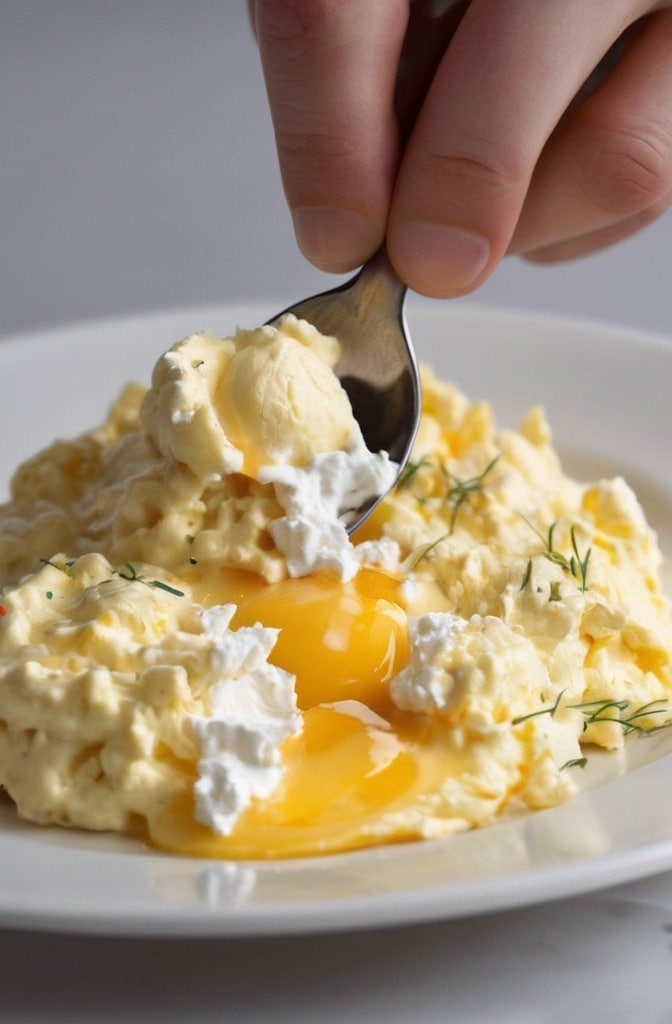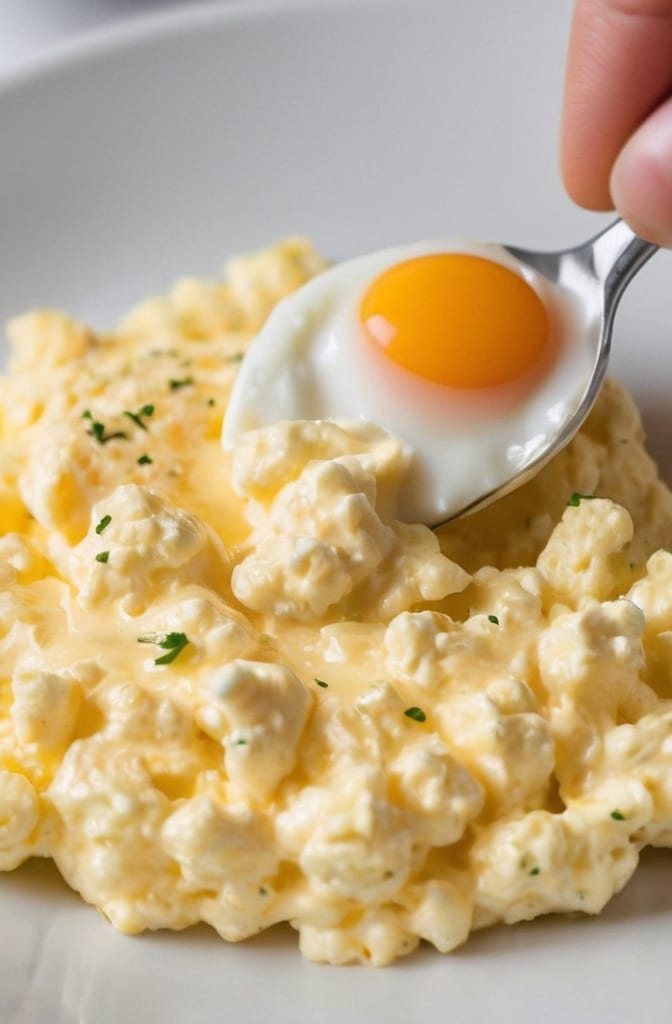Ever had scrambled eggs so soft and custardy they felt like silk melting across your tongue? I have. It was in a tiny apartment kitchen in Lyon, where a tired old French chef dropped a spoonful of fromage blanc into his eggs and whispered, “Les oeufs demandent patience.” Patience, yes. But also cottage cheese. I’m not kidding. That humble, often-ignored tub in your fridge is the secret weapon your scrambled eggs have been waiting for.
Creamy cottage cheese scrambled eggs aren’t some Instagram gimmick. They’re a high-protein, texture-boosted, flavor-balanced twist on a classic. What makes this version special isn’t just the creaminess it’s how the cottage cheese melts into the curds, adding body and depth without overpowering the delicate egg flavor. And yeah, they’ll keep you full ‘til noon without that greasy fry-up fatigue.
This isn’t a quick microwave mug hack. This is the kind of thing chefs make at home for themselves, late at night or early in the day—quiet, unflashy perfection.
What Are Creamy Cottage Cheese Scrambled Eggs?

At its core, it’s a classic scrambled egg technique enhanced with full-fat cottage cheese. When done right, the cheese melts gently into the eggs, creating an impossibly tender, slightly tangy custard. The protein and fat in cottage cheese enrich the eggs without watering them down (if you’re using the right kind more on that soon). It’s like giving your eggs a sous-chef.
The magic? Heat control, timing, and the type of cheese you use.
Ingredients & Substitutions
Eggs – 4 large, pasture-raised if you can swing it.
Look for deep golden yolks. That richness translates directly into flavor and texture. Older eggs peel better when hard-boiled, sure, but for scrambling? Fresher is best.
Cottage Cheese – ¼ cup, full-fat, small-curd.
You need that fat. Low-fat turns watery, and large-curd won’t melt in the same way. If you absolutely can’t stand cottage cheese (but why are you here?), substitute ricotta or a touch of crème fraîche.
Butter – 1 tbsp, unsalted.
You want control over salt. Butter also creates an insulating layer between the eggs and pan. Don’t sub with oil unless you’re in a bind. Ghee? Absolutely.
Salt – A pinch, added late.
Salt too early and the eggs leak moisture.
Pepper – Cracked fresh, please.
It’s eggs. Don’t skimp on the pepper.
Optional extras (choose wisely):
- Chives or dill, finely chopped
- Smoked paprika, for a hit of warmth
- A sprinkle of grated cheddar or Parmesan (if you’re feeling indulgent)
- A few torn spinach leaves or wilted greens if you’re leaning healthy
Dietary swaps:
- Dairy-free? Use a vegan cream cheese alternative, but texture may suffer.
- Egg-free? Honestly, don’t bother. This dish lives and dies on the eggs.
Step-by-Step Instructions
1. Crack and whisk.
Crack your eggs into a bowl ideally metal or glass. Whisk with a fork, not a whisk. A whisk over-aerates. You want them just uniform. Stop when no white streaks remain. No milk, no cream. That’s for omelets.
2. Add cottage cheese gently.
Fold it in. Don’t beat it in. You want little flecks throughout the eggs. The curds will melt in patches, giving creamy pockets without making it soupy.
3. Preheat pan low and slow.
Nonstick or well-seasoned carbon steel, over low heat. Add the butter and let it melt gently, no browning. Swirl it around. If it sizzles loud, it’s too hot.
4. Cook the eggs.
Pour in your egg mixture. Wait a few seconds. Then stir—gently, slowly. Push with a spatula, don’t whip. Scramble like you’re folding laundry. Small movements.
5. Pull them early.
When the eggs look barely done, remove the pan from heat. Residual heat will finish them. If you wait until they look cooked in the pan, they’ll be rubbery by the time they hit the plate.
6. Season last.
Salt and pepper after they’re off the heat. Taste. Adjust.
7. Garnish if you must.
A bit of chopped chive is lovely. A drizzle of olive oil? Fancy. Just don’t overdo it. This dish thrives on restraint.
Common Mistakes to Avoid:
- Too much heat: Eggs are delicate. Low and slow wins every time.
- Beating cottage cheese into oblivion: You’ll lose texture and create watery eggs.
- Salting too early: It pulls moisture and ruins texture. Salt at the end.
- Overcooking: Always—always—pull before they look done.
Cooking Techniques & Science
Let’s talk curds and proteins.
Scrambled eggs work because of the way heat transforms egg proteins. At about 144°F (62°C), egg whites start to coagulate. Yolks follow slightly later. You want to hit that sweet spot where they’ve thickened but haven’t tightened into rubber.
Cottage cheese introduces extra casein proteins and milk fat, both of which change how the eggs set. The fat makes the eggs richer; the casein provides body. But too much? And you get soup.
This is also why you don’t stir like mad more agitation means tighter curds. Gentle folding yields the tender, custard-like texture we’re after.
Tools that matter:
- Silicone spatula: Nothing sticks, and you get control.
- Nonstick pan: Don’t argue. Unless you’re Gordon Ramsay with a copper pan, stick to nonstick.
- Thermometer (optional): If you’re a nerd (like me), you can use an IR thermometer to check surface temp—keep it under 250°F.
Serving & Pairing Suggestions

These eggs are rich and delicate, so don’t bury them under toast avalanches or bacon mountains.
Try pairing with:
- A single slice of sourdough, lightly toasted, rubbed with garlic
- A side of vinegary greens (arugula with lemon and olive oil)
- Sliced tomatoes with flaky salt
- Cold smoked salmon if you’re feeling extra
For drinks:
- A bright, acidic white like Sauvignon Blanc
- Fresh squeezed orange juice or black coffee
- Chilled green tea, if you’re in a wellness mood
Presentation tip:
Use a warm plate. Cold plates ruin soft eggs. Give them space on the plate don’t crowd. A dusting of herbs or smoked salt adds a chef’s touch without fuss.
Conclusion
Cottage cheese scrambled eggs are proof that even the simplest dishes can be elevated with a little technique and thought. They’re creamy, lush, and deeply satisfying not because they’re overloaded with stuff, but because they’re made with care. The beauty of this recipe lies in its restraint and precision. The reward is a breakfast (or dinner, or 2 a.m. snack) that tastes like you know what you’re doing even if you’re still in your pyjamas.

